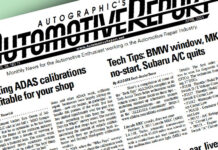A Balanced Approach to Continually Cutting Costs and Increasing Sales
by John Yoswick
If the goal in business is putting more dollars to the bottom line, there are really just two ways to accomplish that: increasing sales or decreasing costs. Small businesses tend to focus on only one of the two at any given time, cutting costs madly during recessionary periods, for example, then scrambling to add new revenue when times are good.
But business trainers and consultants say a more balanced approach of continually working on building sales while reducing expenses is generally the best way to improve your financial bottom line.
Here’s a collection of ideas for ways to do both.
Cut costs by doing a little more of the work yourself
Business owners generally want to get to the point of working ON their business rather than IN the business. But Jesse Thatcher said that Pro Finish, the collision repair business he has owned and operated in Kent, Wash., for the past two decades, benefitted during the recession from his ability to get back out into the shop and do some of the body and paint work himself.
“Now I’m just trying to get all the pieces in place to where the shop doesn’t rely on me 100 percent of the time,” he said. “Since the recession, I think we’re getting back to that again.”
But the lesson, he said, is to get as much as you can out of every employee by recognizing, cultivating and using all of their skills.
Boost sales by remembering to bill for ‘not-included’ procedures you are doing
Mike Anderson of Collision Advice said one of his quarterly “Who Pays for What?” surveys earlier this year found that 30 percent of shops who seek to be paid for “airbag residue clean-up” when it is a necessary part of a vehicle repair said they are paid for the operation “always” or “most of the time” by the eight largest auto insurers. Yet almost two-thirds of the more than 900 shops around the country who took the survey said they’d never even asked to be paid for airbag residue clean-up.
Anderson isn’t sure why so many shops don’t bill for the procedure, but he says he doesn’t think it’s solely because of insurance company resistance.
“They say, ‘The insurance company won’t pay for it,’ when the reality is they didn’t even know they could charge for it,” Anderson said of some shops.
He said just participating in the four different quarterly surveys (https://www.crashnetwork.com/collisionadvice) can be a good reminder of “not-included” operations you may be doing but not charging for. The survey results (which are always free for those who took the survey) also can help demonstrate you’re not “the only one,” asking to be paid for something.
“You may not choose to bill for all of these items every time you do them,” Anderson said. “But you may want to start with one or two of them at a time, focusing on including them on estimates on jobs where the procedure is being done, and being prepared to support why you should be paid for it.”
It’s a great way to reasonably boost your top-line sales without needing to repair any more cars than you currently are.
Cut costs by joining an association
It may seem counter-intuitive to reduce costs by cutting a check to belong to a trade association, but most such groups offer members plenty of discounts on products and services for which you may already be paying more. Judell Anderson of the Alliance of Automotive Service Providers of Minnesota (AASP-MN) said it makes good financial sense for shops in her state to belong to the association.
“In 2015 alone, the association distributed more than $78,000 in rebates to members participating in AASP-MN’s uniform program, and more than $68,000 in dividends to members participating in our garage-keepers’ insurance program,” she said.
Boost sales by cultivating online reviews
More and more consumers are checking out posted customer reviews before purchasing a product or service. You can boost the number of such reviews of your shop by giving every customer a flier with directions on how to go to one or two of the key review websites (e.g., Yelp, Google, etc.) and post a review.
“It’s surprising how many people call us based off those reviews,” Brad Diez of Speedzone Paint & Bodyworks in Santee, Calif., said.
Cut costs by more closely monitoring shop products
Paul Amato believes employees are far less likely to waste shop products — even down to a single piece of sandpaper — if they know they are being held accountable for any such waste. So all the paint preppers at Amato’s Auto Body in San Diego have their own rolling cart of materials, which are filled on Monday morning with that prepper’s name on everything in the cart.
“So if I see a piece of sandpaper on the ground that’s still good, I know which prepper it belongs to,” Amato said.
At Jim & Jack’s Collision Center in El Segundo, Calif., all paint and shop supplies are bar-coded and stored in a single, managed location, with technicians requesting what they need much as they would at a store. Each technician’s “purchases” there are tracked.
“At each payroll, I can see how many hours a technician flagged and what they ‘cost me’ down to the penny in materials,” Richie Kizirian said. “So if one technician cost me 80-cents in materials per flagged hour, and another cost me $2 an hour in materials, I can say, is there a problem here?”
The same system helps track the shop’s paint materials. The system is tied to the shop’s paint mixing scale, so if a painter has “purchased” 12 gallons of clear, the computerized scale records should show that he’s mixed 11.5 or more gallons in that time, or has the extra on his shelf, Kizirian said.
“When I put this program in place, my material bill just plummeted,” said Kizirian, who said it helps encourage technicians to recognize the cost of materials and use it more carefully.
Boost sales by offering more services
Marty Orluck’s father started their business in 1984, offering mechanical repairs. But Orluck’s interest when he joined the company was collision repair and restoration. The two now work together offering all those things at Competition Auto Body in Sandy, Ore.
He said about five years ago they began to refine their company’s “look” and image, which is evident from their website and from the exterior appearance of their property, which combines old-style signage and memorabilia with modern vehicles.
“Combining old and new seems to attract a broad clientele,” Orluck said. “They see that you care about the classic stuff which brings a lot of attention. They like that. But they also see you’re qualified to work on the new stuff.”
Orluck said customers also like that the company offers not only mechanical and collision repair work, but also does glass work and media blasting in-house.
“They can come here and get most of their needs met,” he said.
Cut costs by letting tenants pay your mortgage
Shops that own rather than lease space almost universally say the purchase was the best decision they made. Some of them note that buying or building even more space than they needed was an even better decision.
“In 2000 when we built this building, we cut it in half, and those two businesses that rent the two suites upfront have been paying the mortgage this whole time,” Tamra Rogers of Pacific Coast Auto Body in San Diego, Calif. said. “That was the smartest thing we ever did. It really helped us when we were slow in 2008 and 2009. We would have been in trouble.”
Bob and Jeannie Park used the depressed real estate market several years ago to move their collision repair business, Superior Performance, to a much better location in Portland, Ore.; the building was twice the size they needed, but the income from renting some of it out just made their decision to expand while other businesses were scaling back all the better.
“All the buildings in this area were [vacant and for lease] back then, and we were able to negotiate a great deal,” Bob Park said. “We actually were able to purchase this building, which is very unusual for this part of town. Nobody sells. This area is very desirable both because it’s so close to [downtown Portland] and because there’s no competition.”
Boost sales by offering ‘detail for life’
One sales tool used at McCollum Auto Body, which operates four facilities offering collision repair and mechanical repair in Oregon, is “Detail for Life,” which offers qualifying customers four vehicle details a year. It’s an idea they first heard a decade ago at a Masters School of Autobody Management course.
“That’s sold a lot of jobs,” Joey McCollum said.
McCollum said “Detail for Life” is technically offered only to those with a repair job above $2,500.
“But our [sales staff] can make the decision on whether or not to give it to other customers based on other circumstances they may dealing with,” McCollum said. “So if it makes the difference in getting that $2,200 job, or it’s for a repeat customer, or maybe a single mom stressed out with two or three kids.”
He said the program helps keep their shop fresh in customers’ minds, and gives them an opportunity every few months to see if there’s body or mechanical work that the customer might need.
“We actually have people who haven’t qualified for the program buy it for themselves or others, especially around Christmas,” McCollum said.
Cut costs by going ‘paperless’
If you add up the time and money spent on printing, copying, filing and storing the documents associated with every repair job, you’d see that going “paperless” is a good financial as well as organizational tool.
White’s Collision Service, which operates out of four small-town locations in Oregon, is going “paperless” at its newest location, more out of necessity than choice.
April White said her family’s business acquired a shop in another town that it is now operating only as a satellite estimating center to serve that community. Customer vehicles brought to that location are transported to one of the company’s other three shops .
“Because of the transferring of the work, we’re 100 percent paperless over there,” White said. “We don’t have job jackets because all of the information needs to be in the computer so that everyone can access it.”
She said she’s quickly seeing that eliminating paper files will save the company time and money.
“Once we have the system honed in there, we’ll make that transition to going paperless at our other shops,” she said.
Boost sales by thinking ‘local’
Shop owner Pam Counts is very familiar with the challenge posed by competition from large multi-shop operations (MSOs). Her company, A&D Auto Body, has two locations in the Phoenix, Ariz., area, but about three years ago found its business was down more than 25 percent as ABRA, Caliber, Service King and Gerber all entered or grew in the Phoenix market.
“So it was a little scary for us,” Counts said. “We even share a parking lot with a big MSO. Unfortunately, when you come in our driveway, they’re on one side and we’re on the other side.”
She said her company has fought its way back by playing up the fact that it is a local business.
“A big part of it is really promoting ourselves as family-owned and operated,” Counts said. “You’ll see signs all over the front of our buildings: Shop local. We really promote keeping it local, educating our customers in terms of what ‘shopping local’ means for the local economy.”
Counts said she’s also done something the bigger chains are less likely to do: get very involved in the community.
“We do a lot with all the chambers of commerce that touch either of our shops, and we’re very involved with local businesses, local schools,” she said. •
John Yoswick, a freelance writer based in Portland, Ore., who has been writing about the automotive industry since 1988, is also the editor of the weekly CRASH Network (for more state-by-state numbers or a free 4-week trial subscription, visit www.CrashNetwork.com). He can be contacted by email at jyoswick@SpiritOne.com.



